Strategic Management Report: Tesco PLC Business Analysis and Strategy
VerifiedAdded on 2023/06/18
|17
|5246
|488
Report
AI Summary
This report provides a comprehensive strategic management analysis of Tesco PLC, a leading multinational British retailer. It begins with an introduction to strategic management and its application within organizations, emphasizing the importance of strategic direction for achieving long-term goals and competitive advantage. The report then delves into Tesco's past strategic direction, examining its evolution over the last five years, including its focus on growth, development, and international expansion. It incorporates an analysis of Tesco's external environment using PESTLE and Porter's Five Forces models to identify opportunities and threats. The report also evaluates Tesco's internal environment and capabilities through the Business Canvas model, exploring the extent to which the company faces strategic drift and outlining its mission, vision, and strategic capabilities. Furthermore, the report examines Porter's Generic Strategies and Corporate Direction strategy models to assess Tesco's competitive positioning and strategic choices. Finally, it discusses the evaluation and implementation of these models, considering resource allocation and strategic alignment, culminating in a conclusion that summarizes the key findings and recommendations for Tesco's continued strategic success. The report is supported by references to academic and industry sources.
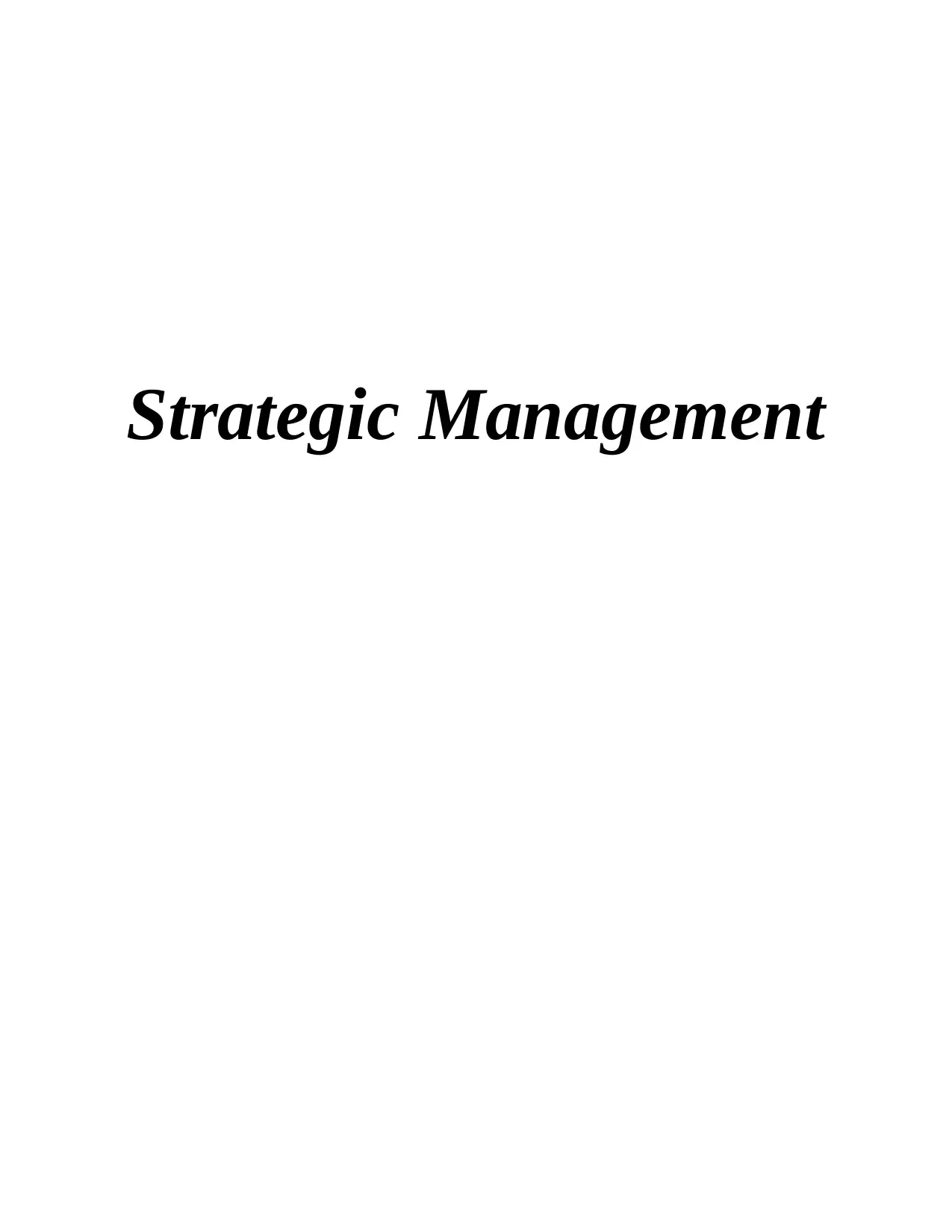
Strategic Management
Paraphrase This Document
Need a fresh take? Get an instant paraphrase of this document with our AI Paraphraser
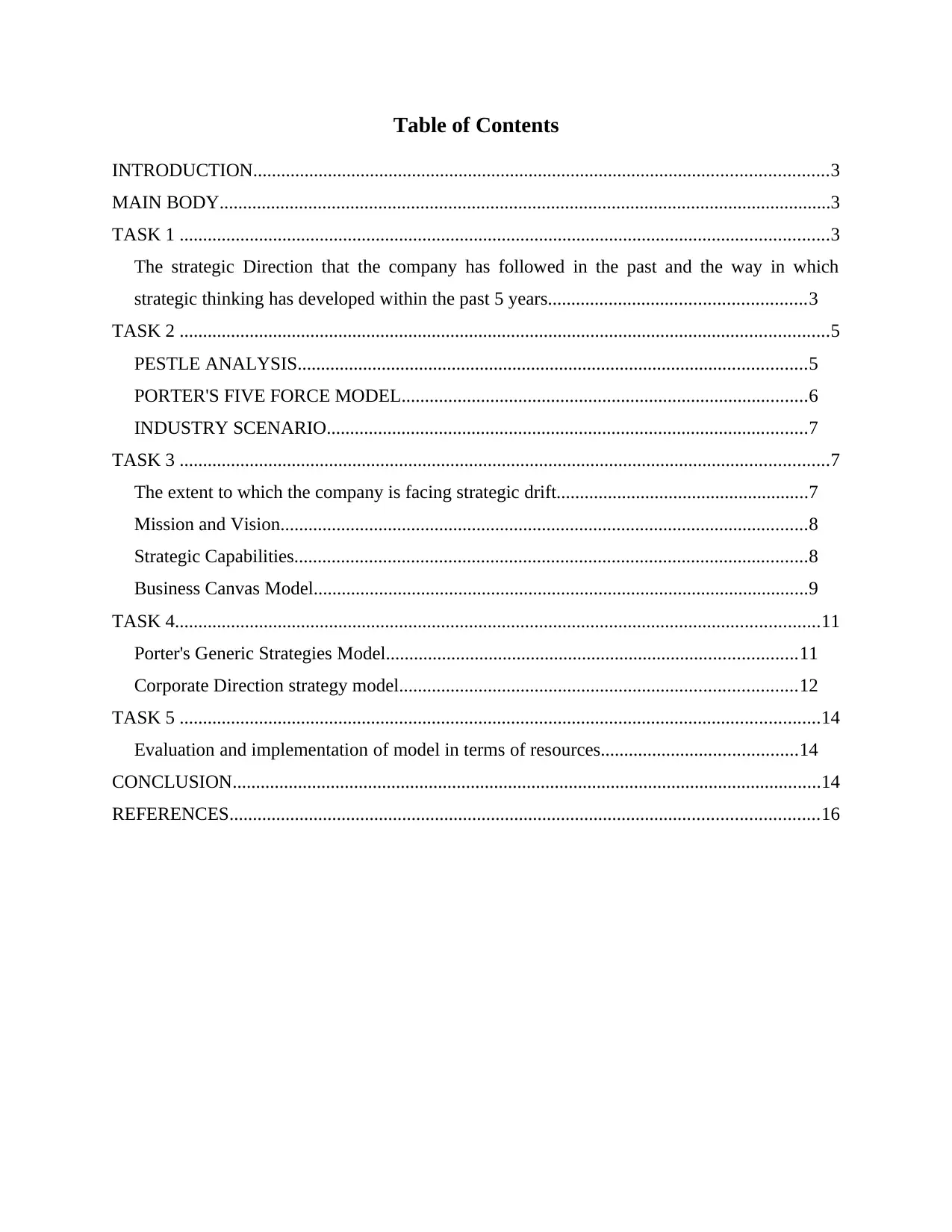
Table of Contents
INTRODUCTION...........................................................................................................................3
MAIN BODY...................................................................................................................................3
TASK 1 ...........................................................................................................................................3
The strategic Direction that the company has followed in the past and the way in which
strategic thinking has developed within the past 5 years.......................................................3
TASK 2 ...........................................................................................................................................5
PESTLE ANALYSIS.............................................................................................................5
PORTER'S FIVE FORCE MODEL.......................................................................................6
INDUSTRY SCENARIO.......................................................................................................7
TASK 3 ...........................................................................................................................................7
The extent to which the company is facing strategic drift......................................................7
Mission and Vision.................................................................................................................8
Strategic Capabilities..............................................................................................................8
Business Canvas Model..........................................................................................................9
TASK 4..........................................................................................................................................11
Porter's Generic Strategies Model........................................................................................11
Corporate Direction strategy model.....................................................................................12
TASK 5 .........................................................................................................................................14
Evaluation and implementation of model in terms of resources..........................................14
CONCLUSION..............................................................................................................................14
REFERENCES..............................................................................................................................16
INTRODUCTION...........................................................................................................................3
MAIN BODY...................................................................................................................................3
TASK 1 ...........................................................................................................................................3
The strategic Direction that the company has followed in the past and the way in which
strategic thinking has developed within the past 5 years.......................................................3
TASK 2 ...........................................................................................................................................5
PESTLE ANALYSIS.............................................................................................................5
PORTER'S FIVE FORCE MODEL.......................................................................................6
INDUSTRY SCENARIO.......................................................................................................7
TASK 3 ...........................................................................................................................................7
The extent to which the company is facing strategic drift......................................................7
Mission and Vision.................................................................................................................8
Strategic Capabilities..............................................................................................................8
Business Canvas Model..........................................................................................................9
TASK 4..........................................................................................................................................11
Porter's Generic Strategies Model........................................................................................11
Corporate Direction strategy model.....................................................................................12
TASK 5 .........................................................................................................................................14
Evaluation and implementation of model in terms of resources..........................................14
CONCLUSION..............................................................................................................................14
REFERENCES..............................................................................................................................16
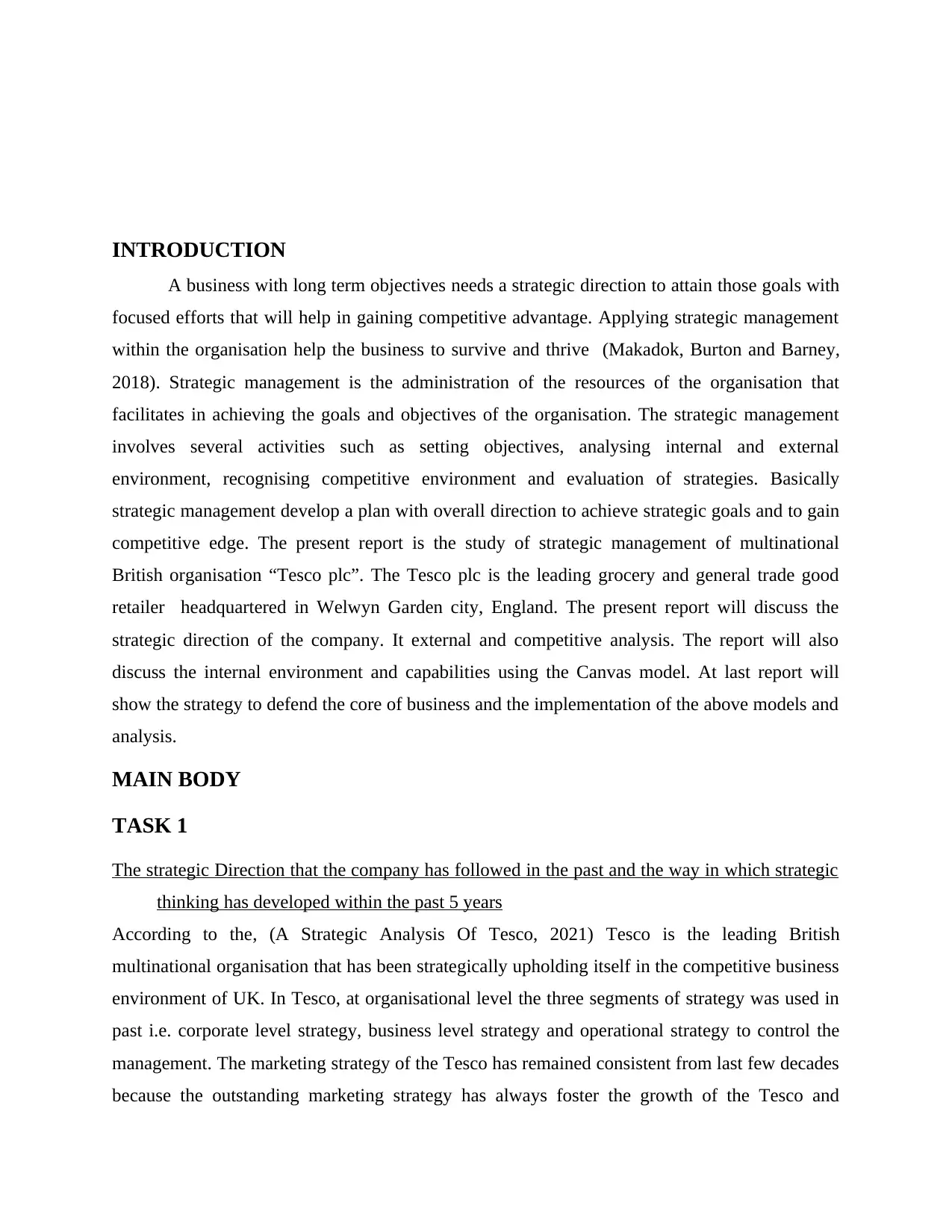
INTRODUCTION
A business with long term objectives needs a strategic direction to attain those goals with
focused efforts that will help in gaining competitive advantage. Applying strategic management
within the organisation help the business to survive and thrive (Makadok, Burton and Barney,
2018). Strategic management is the administration of the resources of the organisation that
facilitates in achieving the goals and objectives of the organisation. The strategic management
involves several activities such as setting objectives, analysing internal and external
environment, recognising competitive environment and evaluation of strategies. Basically
strategic management develop a plan with overall direction to achieve strategic goals and to gain
competitive edge. The present report is the study of strategic management of multinational
British organisation “Tesco plc”. The Tesco plc is the leading grocery and general trade good
retailer headquartered in Welwyn Garden city, England. The present report will discuss the
strategic direction of the company. It external and competitive analysis. The report will also
discuss the internal environment and capabilities using the Canvas model. At last report will
show the strategy to defend the core of business and the implementation of the above models and
analysis.
MAIN BODY
TASK 1
The strategic Direction that the company has followed in the past and the way in which strategic
thinking has developed within the past 5 years
According to the, (A Strategic Analysis Of Tesco, 2021) Tesco is the leading British
multinational organisation that has been strategically upholding itself in the competitive business
environment of UK. In Tesco, at organisational level the three segments of strategy was used in
past i.e. corporate level strategy, business level strategy and operational strategy to control the
management. The marketing strategy of the Tesco has remained consistent from last few decades
because the outstanding marketing strategy has always foster the growth of the Tesco and
A business with long term objectives needs a strategic direction to attain those goals with
focused efforts that will help in gaining competitive advantage. Applying strategic management
within the organisation help the business to survive and thrive (Makadok, Burton and Barney,
2018). Strategic management is the administration of the resources of the organisation that
facilitates in achieving the goals and objectives of the organisation. The strategic management
involves several activities such as setting objectives, analysing internal and external
environment, recognising competitive environment and evaluation of strategies. Basically
strategic management develop a plan with overall direction to achieve strategic goals and to gain
competitive edge. The present report is the study of strategic management of multinational
British organisation “Tesco plc”. The Tesco plc is the leading grocery and general trade good
retailer headquartered in Welwyn Garden city, England. The present report will discuss the
strategic direction of the company. It external and competitive analysis. The report will also
discuss the internal environment and capabilities using the Canvas model. At last report will
show the strategy to defend the core of business and the implementation of the above models and
analysis.
MAIN BODY
TASK 1
The strategic Direction that the company has followed in the past and the way in which strategic
thinking has developed within the past 5 years
According to the, (A Strategic Analysis Of Tesco, 2021) Tesco is the leading British
multinational organisation that has been strategically upholding itself in the competitive business
environment of UK. In Tesco, at organisational level the three segments of strategy was used in
past i.e. corporate level strategy, business level strategy and operational strategy to control the
management. The marketing strategy of the Tesco has remained consistent from last few decades
because the outstanding marketing strategy has always foster the growth of the Tesco and
⊘ This is a preview!⊘
Do you want full access?
Subscribe today to unlock all pages.

Trusted by 1+ million students worldwide
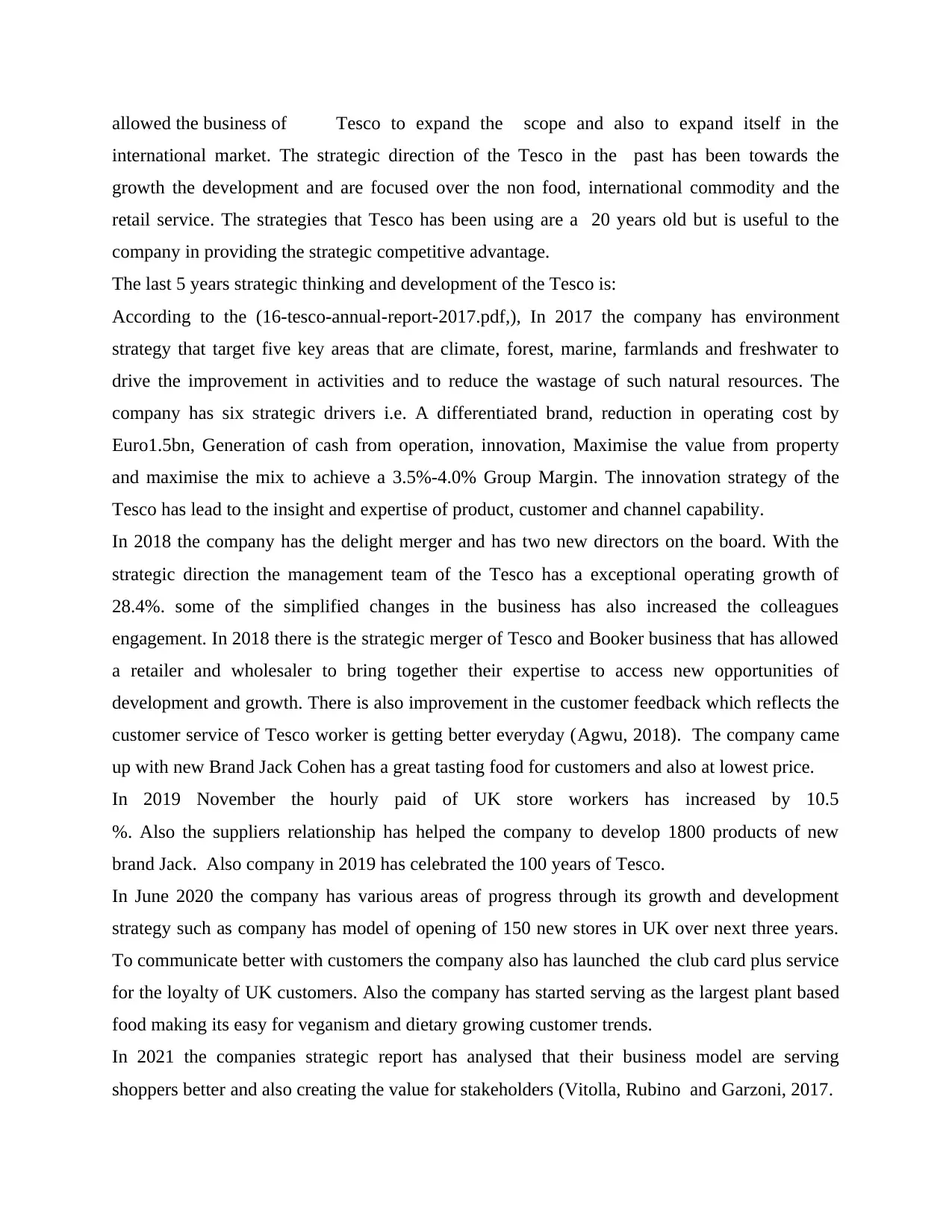
allowed the business of Tesco to expand the scope and also to expand itself in the
international market. The strategic direction of the Tesco in the past has been towards the
growth the development and are focused over the non food, international commodity and the
retail service. The strategies that Tesco has been using are a 20 years old but is useful to the
company in providing the strategic competitive advantage.
The last 5 years strategic thinking and development of the Tesco is:
According to the (16-tesco-annual-report-2017.pdf,), In 2017 the company has environment
strategy that target five key areas that are climate, forest, marine, farmlands and freshwater to
drive the improvement in activities and to reduce the wastage of such natural resources. The
company has six strategic drivers i.e. A differentiated brand, reduction in operating cost by
Euro1.5bn, Generation of cash from operation, innovation, Maximise the value from property
and maximise the mix to achieve a 3.5%-4.0% Group Margin. The innovation strategy of the
Tesco has lead to the insight and expertise of product, customer and channel capability.
In 2018 the company has the delight merger and has two new directors on the board. With the
strategic direction the management team of the Tesco has a exceptional operating growth of
28.4%. some of the simplified changes in the business has also increased the colleagues
engagement. In 2018 there is the strategic merger of Tesco and Booker business that has allowed
a retailer and wholesaler to bring together their expertise to access new opportunities of
development and growth. There is also improvement in the customer feedback which reflects the
customer service of Tesco worker is getting better everyday (Agwu, 2018). The company came
up with new Brand Jack Cohen has a great tasting food for customers and also at lowest price.
In 2019 November the hourly paid of UK store workers has increased by 10.5
%. Also the suppliers relationship has helped the company to develop 1800 products of new
brand Jack. Also company in 2019 has celebrated the 100 years of Tesco.
In June 2020 the company has various areas of progress through its growth and development
strategy such as company has model of opening of 150 new stores in UK over next three years.
To communicate better with customers the company also has launched the club card plus service
for the loyalty of UK customers. Also the company has started serving as the largest plant based
food making its easy for veganism and dietary growing customer trends.
In 2021 the companies strategic report has analysed that their business model are serving
shoppers better and also creating the value for stakeholders (Vitolla, Rubino and Garzoni, 2017.
international market. The strategic direction of the Tesco in the past has been towards the
growth the development and are focused over the non food, international commodity and the
retail service. The strategies that Tesco has been using are a 20 years old but is useful to the
company in providing the strategic competitive advantage.
The last 5 years strategic thinking and development of the Tesco is:
According to the (16-tesco-annual-report-2017.pdf,), In 2017 the company has environment
strategy that target five key areas that are climate, forest, marine, farmlands and freshwater to
drive the improvement in activities and to reduce the wastage of such natural resources. The
company has six strategic drivers i.e. A differentiated brand, reduction in operating cost by
Euro1.5bn, Generation of cash from operation, innovation, Maximise the value from property
and maximise the mix to achieve a 3.5%-4.0% Group Margin. The innovation strategy of the
Tesco has lead to the insight and expertise of product, customer and channel capability.
In 2018 the company has the delight merger and has two new directors on the board. With the
strategic direction the management team of the Tesco has a exceptional operating growth of
28.4%. some of the simplified changes in the business has also increased the colleagues
engagement. In 2018 there is the strategic merger of Tesco and Booker business that has allowed
a retailer and wholesaler to bring together their expertise to access new opportunities of
development and growth. There is also improvement in the customer feedback which reflects the
customer service of Tesco worker is getting better everyday (Agwu, 2018). The company came
up with new Brand Jack Cohen has a great tasting food for customers and also at lowest price.
In 2019 November the hourly paid of UK store workers has increased by 10.5
%. Also the suppliers relationship has helped the company to develop 1800 products of new
brand Jack. Also company in 2019 has celebrated the 100 years of Tesco.
In June 2020 the company has various areas of progress through its growth and development
strategy such as company has model of opening of 150 new stores in UK over next three years.
To communicate better with customers the company also has launched the club card plus service
for the loyalty of UK customers. Also the company has started serving as the largest plant based
food making its easy for veganism and dietary growing customer trends.
In 2021 the companies strategic report has analysed that their business model are serving
shoppers better and also creating the value for stakeholders (Vitolla, Rubino and Garzoni, 2017.
Paraphrase This Document
Need a fresh take? Get an instant paraphrase of this document with our AI Paraphraser
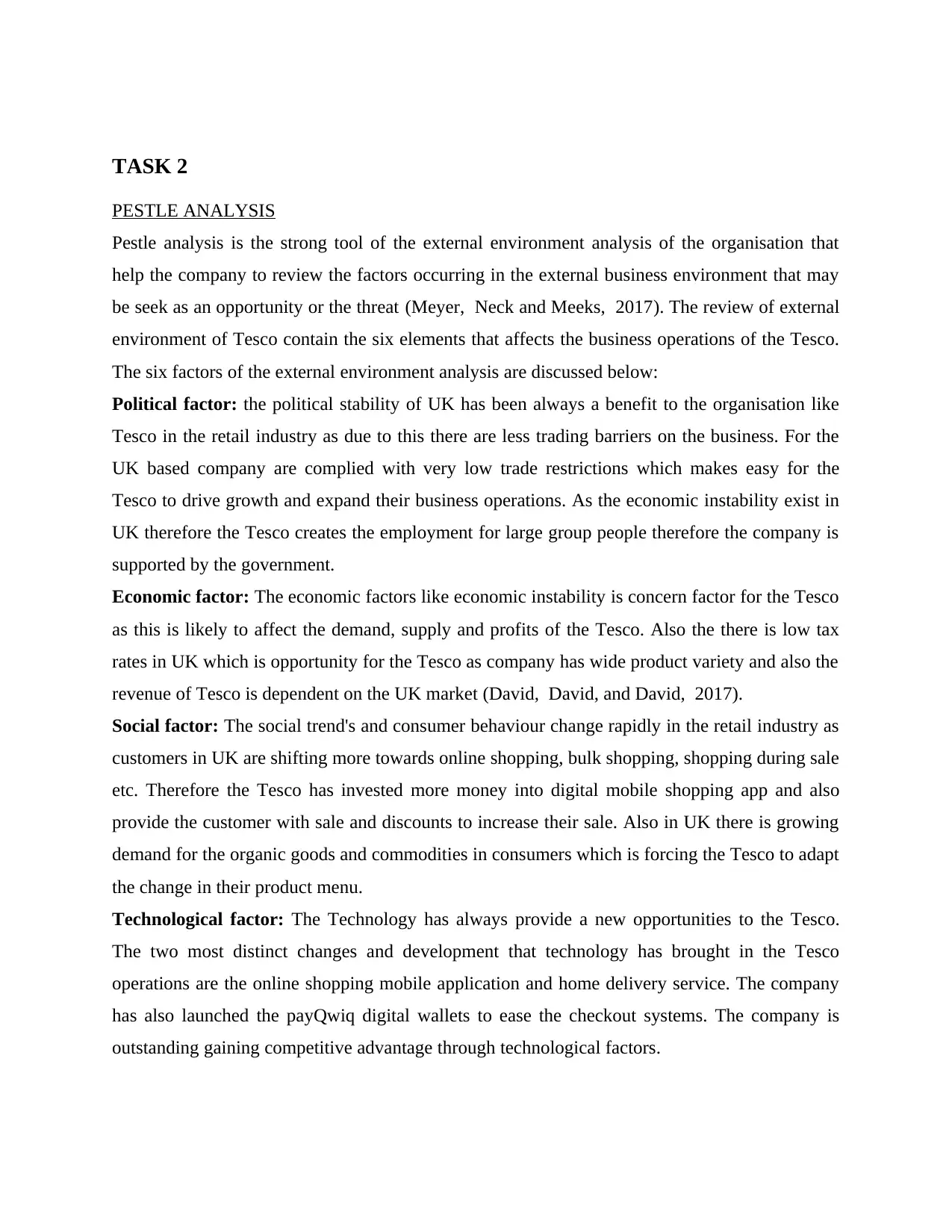
TASK 2
PESTLE ANALYSIS
Pestle analysis is the strong tool of the external environment analysis of the organisation that
help the company to review the factors occurring in the external business environment that may
be seek as an opportunity or the threat (Meyer, Neck and Meeks, 2017). The review of external
environment of Tesco contain the six elements that affects the business operations of the Tesco.
The six factors of the external environment analysis are discussed below:
Political factor: the political stability of UK has been always a benefit to the organisation like
Tesco in the retail industry as due to this there are less trading barriers on the business. For the
UK based company are complied with very low trade restrictions which makes easy for the
Tesco to drive growth and expand their business operations. As the economic instability exist in
UK therefore the Tesco creates the employment for large group people therefore the company is
supported by the government.
Economic factor: The economic factors like economic instability is concern factor for the Tesco
as this is likely to affect the demand, supply and profits of the Tesco. Also the there is low tax
rates in UK which is opportunity for the Tesco as company has wide product variety and also the
revenue of Tesco is dependent on the UK market (David, David, and David, 2017).
Social factor: The social trend's and consumer behaviour change rapidly in the retail industry as
customers in UK are shifting more towards online shopping, bulk shopping, shopping during sale
etc. Therefore the Tesco has invested more money into digital mobile shopping app and also
provide the customer with sale and discounts to increase their sale. Also in UK there is growing
demand for the organic goods and commodities in consumers which is forcing the Tesco to adapt
the change in their product menu.
Technological factor: The Technology has always provide a new opportunities to the Tesco.
The two most distinct changes and development that technology has brought in the Tesco
operations are the online shopping mobile application and home delivery service. The company
has also launched the payQwiq digital wallets to ease the checkout systems. The company is
outstanding gaining competitive advantage through technological factors.
PESTLE ANALYSIS
Pestle analysis is the strong tool of the external environment analysis of the organisation that
help the company to review the factors occurring in the external business environment that may
be seek as an opportunity or the threat (Meyer, Neck and Meeks, 2017). The review of external
environment of Tesco contain the six elements that affects the business operations of the Tesco.
The six factors of the external environment analysis are discussed below:
Political factor: the political stability of UK has been always a benefit to the organisation like
Tesco in the retail industry as due to this there are less trading barriers on the business. For the
UK based company are complied with very low trade restrictions which makes easy for the
Tesco to drive growth and expand their business operations. As the economic instability exist in
UK therefore the Tesco creates the employment for large group people therefore the company is
supported by the government.
Economic factor: The economic factors like economic instability is concern factor for the Tesco
as this is likely to affect the demand, supply and profits of the Tesco. Also the there is low tax
rates in UK which is opportunity for the Tesco as company has wide product variety and also the
revenue of Tesco is dependent on the UK market (David, David, and David, 2017).
Social factor: The social trend's and consumer behaviour change rapidly in the retail industry as
customers in UK are shifting more towards online shopping, bulk shopping, shopping during sale
etc. Therefore the Tesco has invested more money into digital mobile shopping app and also
provide the customer with sale and discounts to increase their sale. Also in UK there is growing
demand for the organic goods and commodities in consumers which is forcing the Tesco to adapt
the change in their product menu.
Technological factor: The Technology has always provide a new opportunities to the Tesco.
The two most distinct changes and development that technology has brought in the Tesco
operations are the online shopping mobile application and home delivery service. The company
has also launched the payQwiq digital wallets to ease the checkout systems. The company is
outstanding gaining competitive advantage through technological factors.
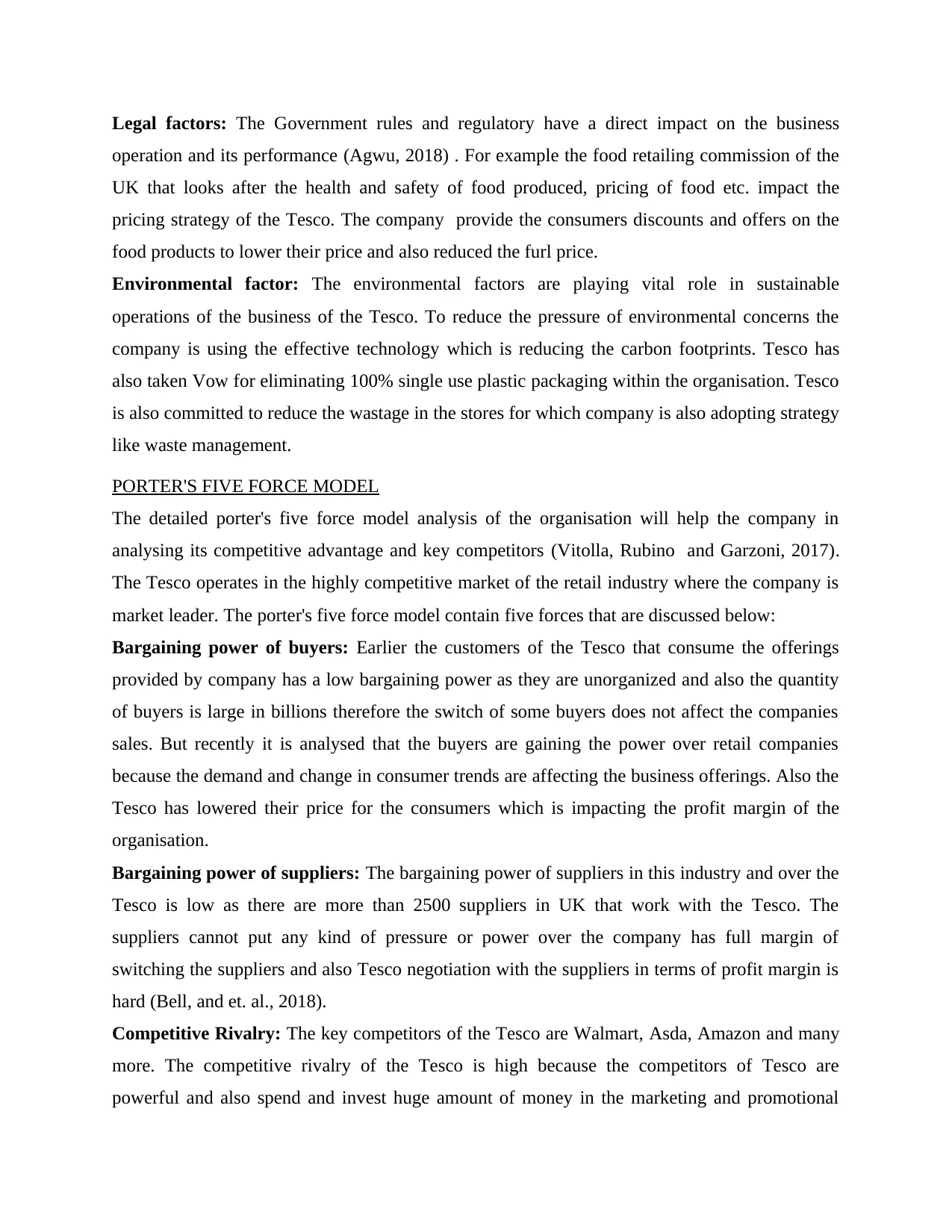
Legal factors: The Government rules and regulatory have a direct impact on the business
operation and its performance (Agwu, 2018) . For example the food retailing commission of the
UK that looks after the health and safety of food produced, pricing of food etc. impact the
pricing strategy of the Tesco. The company provide the consumers discounts and offers on the
food products to lower their price and also reduced the furl price.
Environmental factor: The environmental factors are playing vital role in sustainable
operations of the business of the Tesco. To reduce the pressure of environmental concerns the
company is using the effective technology which is reducing the carbon footprints. Tesco has
also taken Vow for eliminating 100% single use plastic packaging within the organisation. Tesco
is also committed to reduce the wastage in the stores for which company is also adopting strategy
like waste management.
PORTER'S FIVE FORCE MODEL
The detailed porter's five force model analysis of the organisation will help the company in
analysing its competitive advantage and key competitors (Vitolla, Rubino and Garzoni, 2017).
The Tesco operates in the highly competitive market of the retail industry where the company is
market leader. The porter's five force model contain five forces that are discussed below:
Bargaining power of buyers: Earlier the customers of the Tesco that consume the offerings
provided by company has a low bargaining power as they are unorganized and also the quantity
of buyers is large in billions therefore the switch of some buyers does not affect the companies
sales. But recently it is analysed that the buyers are gaining the power over retail companies
because the demand and change in consumer trends are affecting the business offerings. Also the
Tesco has lowered their price for the consumers which is impacting the profit margin of the
organisation.
Bargaining power of suppliers: The bargaining power of suppliers in this industry and over the
Tesco is low as there are more than 2500 suppliers in UK that work with the Tesco. The
suppliers cannot put any kind of pressure or power over the company has full margin of
switching the suppliers and also Tesco negotiation with the suppliers in terms of profit margin is
hard (Bell, and et. al., 2018).
Competitive Rivalry: The key competitors of the Tesco are Walmart, Asda, Amazon and many
more. The competitive rivalry of the Tesco is high because the competitors of Tesco are
powerful and also spend and invest huge amount of money in the marketing and promotional
operation and its performance (Agwu, 2018) . For example the food retailing commission of the
UK that looks after the health and safety of food produced, pricing of food etc. impact the
pricing strategy of the Tesco. The company provide the consumers discounts and offers on the
food products to lower their price and also reduced the furl price.
Environmental factor: The environmental factors are playing vital role in sustainable
operations of the business of the Tesco. To reduce the pressure of environmental concerns the
company is using the effective technology which is reducing the carbon footprints. Tesco has
also taken Vow for eliminating 100% single use plastic packaging within the organisation. Tesco
is also committed to reduce the wastage in the stores for which company is also adopting strategy
like waste management.
PORTER'S FIVE FORCE MODEL
The detailed porter's five force model analysis of the organisation will help the company in
analysing its competitive advantage and key competitors (Vitolla, Rubino and Garzoni, 2017).
The Tesco operates in the highly competitive market of the retail industry where the company is
market leader. The porter's five force model contain five forces that are discussed below:
Bargaining power of buyers: Earlier the customers of the Tesco that consume the offerings
provided by company has a low bargaining power as they are unorganized and also the quantity
of buyers is large in billions therefore the switch of some buyers does not affect the companies
sales. But recently it is analysed that the buyers are gaining the power over retail companies
because the demand and change in consumer trends are affecting the business offerings. Also the
Tesco has lowered their price for the consumers which is impacting the profit margin of the
organisation.
Bargaining power of suppliers: The bargaining power of suppliers in this industry and over the
Tesco is low as there are more than 2500 suppliers in UK that work with the Tesco. The
suppliers cannot put any kind of pressure or power over the company has full margin of
switching the suppliers and also Tesco negotiation with the suppliers in terms of profit margin is
hard (Bell, and et. al., 2018).
Competitive Rivalry: The key competitors of the Tesco are Walmart, Asda, Amazon and many
more. The competitive rivalry of the Tesco is high because the competitors of Tesco are
powerful and also spend and invest huge amount of money in the marketing and promotional
⊘ This is a preview!⊘
Do you want full access?
Subscribe today to unlock all pages.

Trusted by 1+ million students worldwide
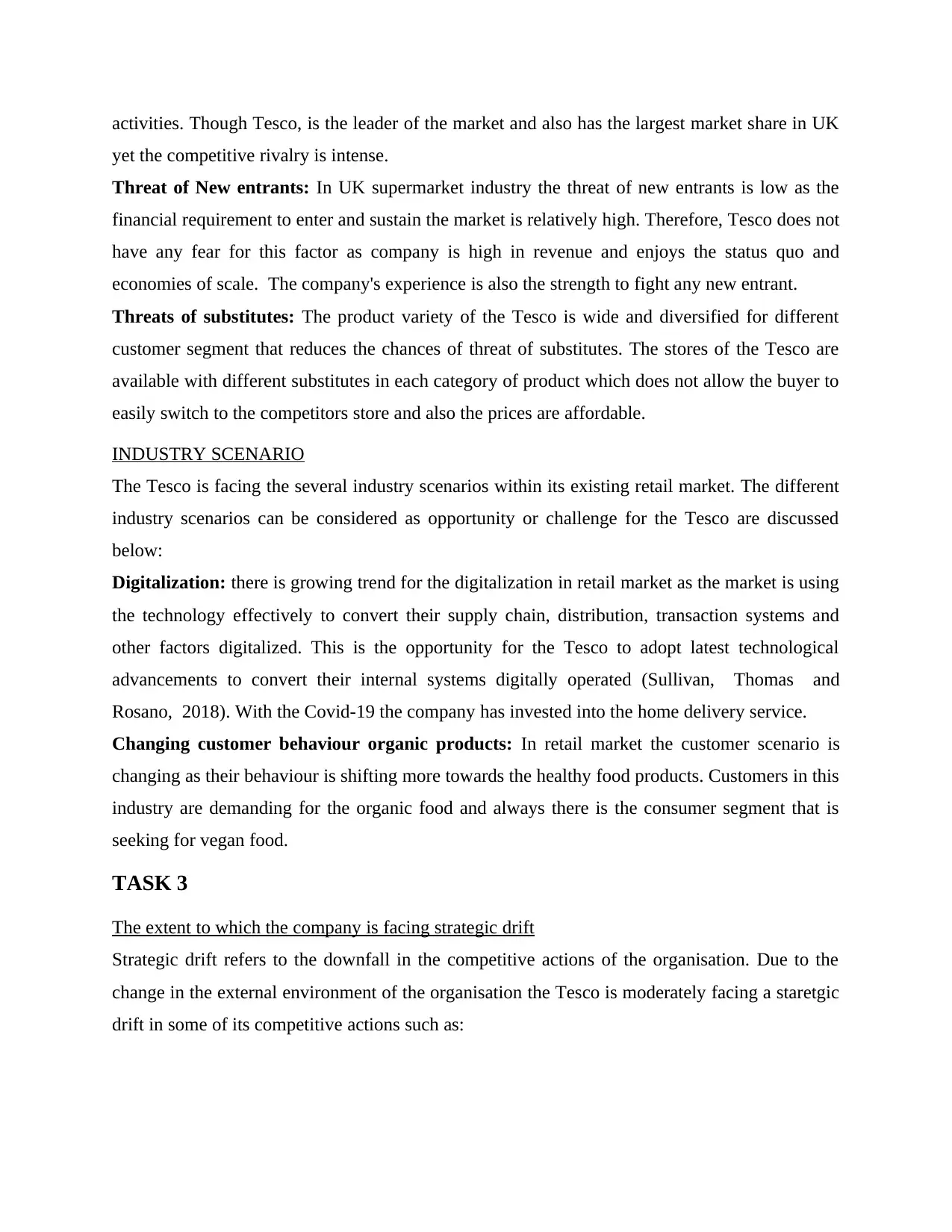
activities. Though Tesco, is the leader of the market and also has the largest market share in UK
yet the competitive rivalry is intense.
Threat of New entrants: In UK supermarket industry the threat of new entrants is low as the
financial requirement to enter and sustain the market is relatively high. Therefore, Tesco does not
have any fear for this factor as company is high in revenue and enjoys the status quo and
economies of scale. The company's experience is also the strength to fight any new entrant.
Threats of substitutes: The product variety of the Tesco is wide and diversified for different
customer segment that reduces the chances of threat of substitutes. The stores of the Tesco are
available with different substitutes in each category of product which does not allow the buyer to
easily switch to the competitors store and also the prices are affordable.
INDUSTRY SCENARIO
The Tesco is facing the several industry scenarios within its existing retail market. The different
industry scenarios can be considered as opportunity or challenge for the Tesco are discussed
below:
Digitalization: there is growing trend for the digitalization in retail market as the market is using
the technology effectively to convert their supply chain, distribution, transaction systems and
other factors digitalized. This is the opportunity for the Tesco to adopt latest technological
advancements to convert their internal systems digitally operated (Sullivan, Thomas and
Rosano, 2018). With the Covid-19 the company has invested into the home delivery service.
Changing customer behaviour organic products: In retail market the customer scenario is
changing as their behaviour is shifting more towards the healthy food products. Customers in this
industry are demanding for the organic food and always there is the consumer segment that is
seeking for vegan food.
TASK 3
The extent to which the company is facing strategic drift
Strategic drift refers to the downfall in the competitive actions of the organisation. Due to the
change in the external environment of the organisation the Tesco is moderately facing a staretgic
drift in some of its competitive actions such as:
yet the competitive rivalry is intense.
Threat of New entrants: In UK supermarket industry the threat of new entrants is low as the
financial requirement to enter and sustain the market is relatively high. Therefore, Tesco does not
have any fear for this factor as company is high in revenue and enjoys the status quo and
economies of scale. The company's experience is also the strength to fight any new entrant.
Threats of substitutes: The product variety of the Tesco is wide and diversified for different
customer segment that reduces the chances of threat of substitutes. The stores of the Tesco are
available with different substitutes in each category of product which does not allow the buyer to
easily switch to the competitors store and also the prices are affordable.
INDUSTRY SCENARIO
The Tesco is facing the several industry scenarios within its existing retail market. The different
industry scenarios can be considered as opportunity or challenge for the Tesco are discussed
below:
Digitalization: there is growing trend for the digitalization in retail market as the market is using
the technology effectively to convert their supply chain, distribution, transaction systems and
other factors digitalized. This is the opportunity for the Tesco to adopt latest technological
advancements to convert their internal systems digitally operated (Sullivan, Thomas and
Rosano, 2018). With the Covid-19 the company has invested into the home delivery service.
Changing customer behaviour organic products: In retail market the customer scenario is
changing as their behaviour is shifting more towards the healthy food products. Customers in this
industry are demanding for the organic food and always there is the consumer segment that is
seeking for vegan food.
TASK 3
The extent to which the company is facing strategic drift
Strategic drift refers to the downfall in the competitive actions of the organisation. Due to the
change in the external environment of the organisation the Tesco is moderately facing a staretgic
drift in some of its competitive actions such as:
Paraphrase This Document
Need a fresh take? Get an instant paraphrase of this document with our AI Paraphraser
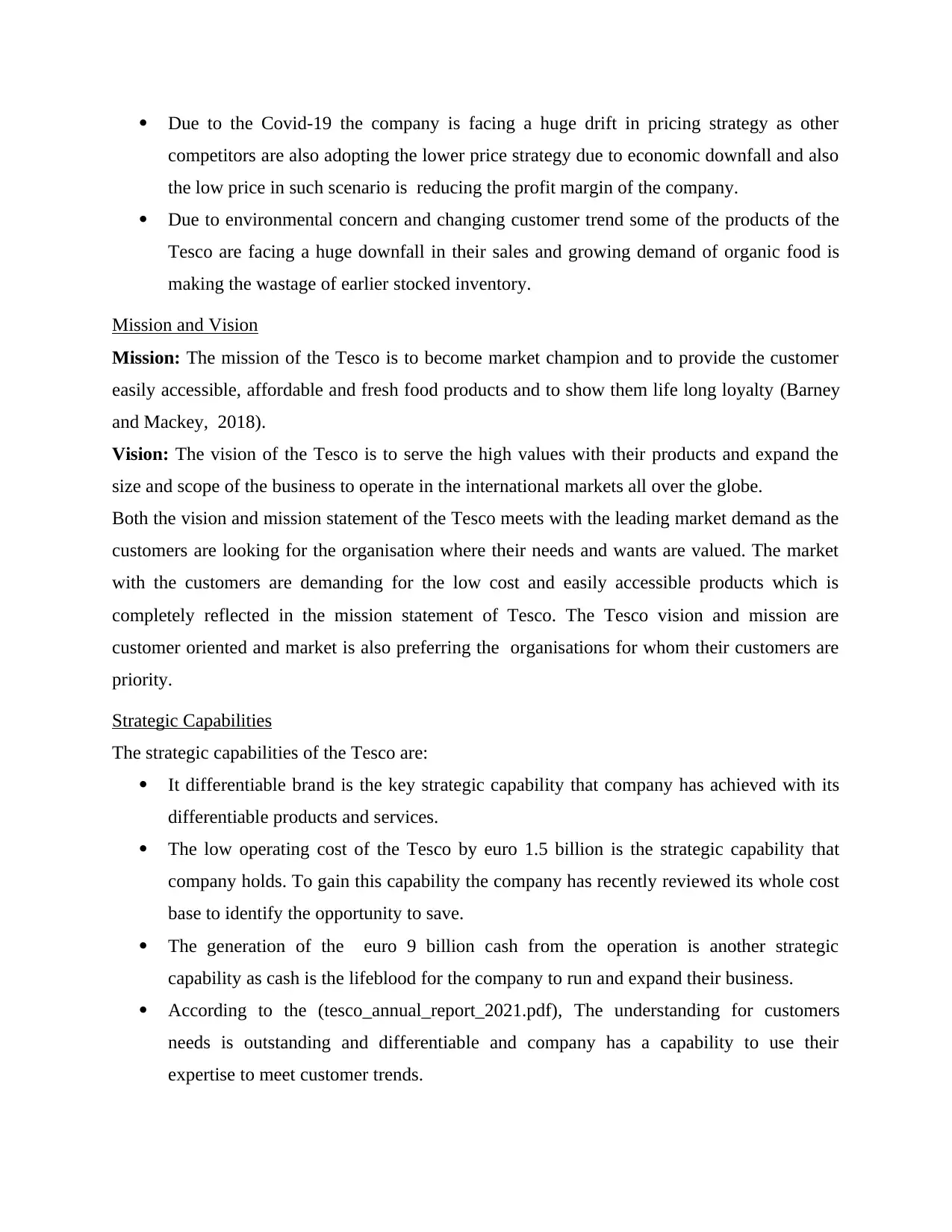
Due to the Covid-19 the company is facing a huge drift in pricing strategy as other
competitors are also adopting the lower price strategy due to economic downfall and also
the low price in such scenario is reducing the profit margin of the company.
Due to environmental concern and changing customer trend some of the products of the
Tesco are facing a huge downfall in their sales and growing demand of organic food is
making the wastage of earlier stocked inventory.
Mission and Vision
Mission: The mission of the Tesco is to become market champion and to provide the customer
easily accessible, affordable and fresh food products and to show them life long loyalty (Barney
and Mackey, 2018).
Vision: The vision of the Tesco is to serve the high values with their products and expand the
size and scope of the business to operate in the international markets all over the globe.
Both the vision and mission statement of the Tesco meets with the leading market demand as the
customers are looking for the organisation where their needs and wants are valued. The market
with the customers are demanding for the low cost and easily accessible products which is
completely reflected in the mission statement of Tesco. The Tesco vision and mission are
customer oriented and market is also preferring the organisations for whom their customers are
priority.
Strategic Capabilities
The strategic capabilities of the Tesco are:
It differentiable brand is the key strategic capability that company has achieved with its
differentiable products and services.
The low operating cost of the Tesco by euro 1.5 billion is the strategic capability that
company holds. To gain this capability the company has recently reviewed its whole cost
base to identify the opportunity to save.
The generation of the euro 9 billion cash from the operation is another strategic
capability as cash is the lifeblood for the company to run and expand their business.
According to the (tesco_annual_report_2021.pdf), The understanding for customers
needs is outstanding and differentiable and company has a capability to use their
expertise to meet customer trends.
competitors are also adopting the lower price strategy due to economic downfall and also
the low price in such scenario is reducing the profit margin of the company.
Due to environmental concern and changing customer trend some of the products of the
Tesco are facing a huge downfall in their sales and growing demand of organic food is
making the wastage of earlier stocked inventory.
Mission and Vision
Mission: The mission of the Tesco is to become market champion and to provide the customer
easily accessible, affordable and fresh food products and to show them life long loyalty (Barney
and Mackey, 2018).
Vision: The vision of the Tesco is to serve the high values with their products and expand the
size and scope of the business to operate in the international markets all over the globe.
Both the vision and mission statement of the Tesco meets with the leading market demand as the
customers are looking for the organisation where their needs and wants are valued. The market
with the customers are demanding for the low cost and easily accessible products which is
completely reflected in the mission statement of Tesco. The Tesco vision and mission are
customer oriented and market is also preferring the organisations for whom their customers are
priority.
Strategic Capabilities
The strategic capabilities of the Tesco are:
It differentiable brand is the key strategic capability that company has achieved with its
differentiable products and services.
The low operating cost of the Tesco by euro 1.5 billion is the strategic capability that
company holds. To gain this capability the company has recently reviewed its whole cost
base to identify the opportunity to save.
The generation of the euro 9 billion cash from the operation is another strategic
capability as cash is the lifeblood for the company to run and expand their business.
According to the (tesco_annual_report_2021.pdf), The understanding for customers
needs is outstanding and differentiable and company has a capability to use their
expertise to meet customer trends.
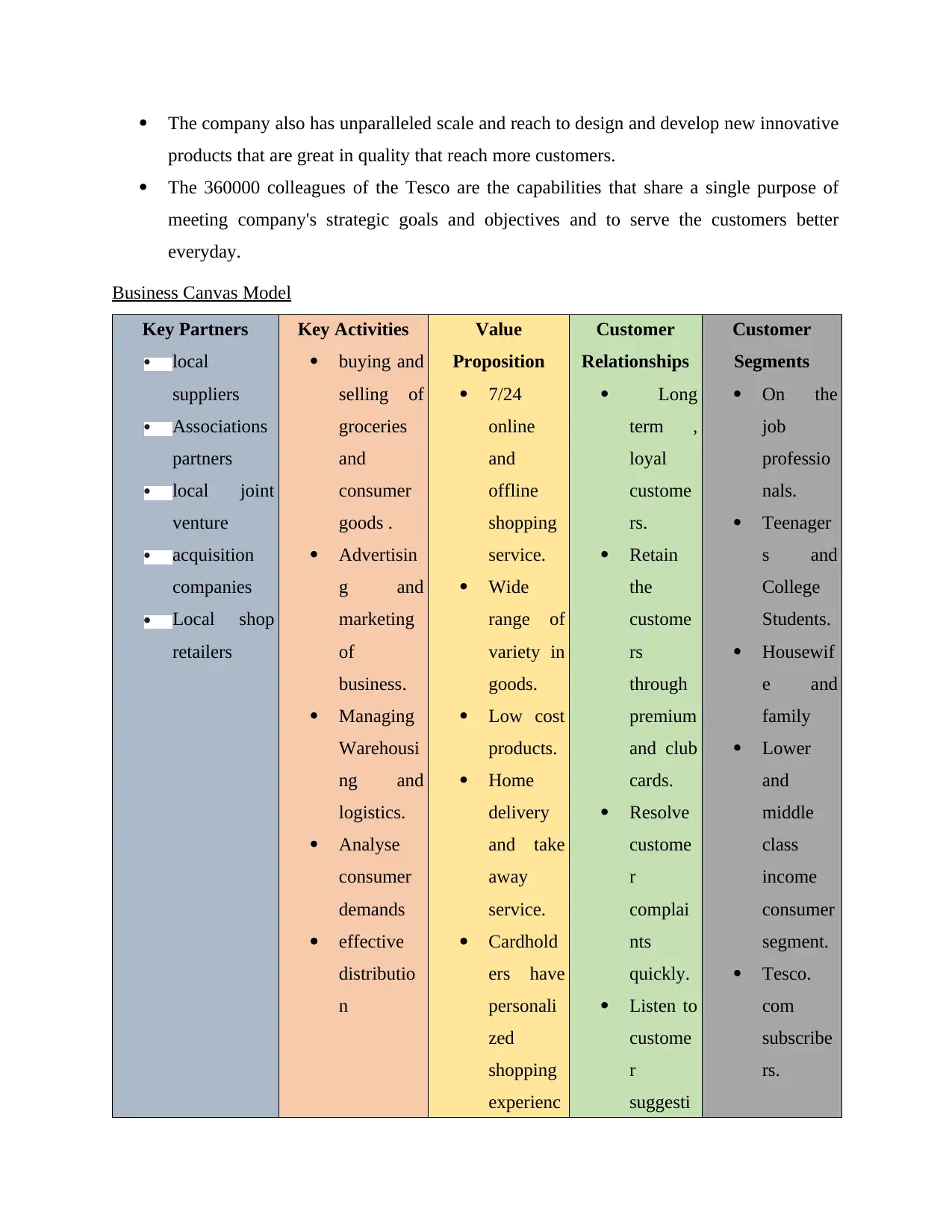
The company also has unparalleled scale and reach to design and develop new innovative
products that are great in quality that reach more customers.
The 360000 colleagues of the Tesco are the capabilities that share a single purpose of
meeting company's strategic goals and objectives and to serve the customers better
everyday.
Business Canvas Model
Key Partners
local
suppliers
Associations
partners
local joint
venture
acquisition
companies
Local shop
retailers
Key Activities
buying and
selling of
groceries
and
consumer
goods .
Advertisin
g and
marketing
of
business.
Managing
Warehousi
ng and
logistics.
Analyse
consumer
demands
effective
distributio
n
Value
Proposition
7/24
online
and
offline
shopping
service.
Wide
range of
variety in
goods.
Low cost
products.
Home
delivery
and take
away
service.
Cardhold
ers have
personali
zed
shopping
experienc
Customer
Relationships
Long
term ,
loyal
custome
rs.
Retain
the
custome
rs
through
premium
and club
cards.
Resolve
custome
r
complai
nts
quickly.
Listen to
custome
r
suggesti
Customer
Segments
On the
job
professio
nals.
Teenager
s and
College
Students.
Housewif
e and
family
Lower
and
middle
class
income
consumer
segment.
Tesco.
com
subscribe
rs.
products that are great in quality that reach more customers.
The 360000 colleagues of the Tesco are the capabilities that share a single purpose of
meeting company's strategic goals and objectives and to serve the customers better
everyday.
Business Canvas Model
Key Partners
local
suppliers
Associations
partners
local joint
venture
acquisition
companies
Local shop
retailers
Key Activities
buying and
selling of
groceries
and
consumer
goods .
Advertisin
g and
marketing
of
business.
Managing
Warehousi
ng and
logistics.
Analyse
consumer
demands
effective
distributio
n
Value
Proposition
7/24
online
and
offline
shopping
service.
Wide
range of
variety in
goods.
Low cost
products.
Home
delivery
and take
away
service.
Cardhold
ers have
personali
zed
shopping
experienc
Customer
Relationships
Long
term ,
loyal
custome
rs.
Retain
the
custome
rs
through
premium
and club
cards.
Resolve
custome
r
complai
nts
quickly.
Listen to
custome
r
suggesti
Customer
Segments
On the
job
professio
nals.
Teenager
s and
College
Students.
Housewif
e and
family
Lower
and
middle
class
income
consumer
segment.
Tesco.
com
subscribe
rs.
⊘ This is a preview!⊘
Do you want full access?
Subscribe today to unlock all pages.

Trusted by 1+ million students worldwide
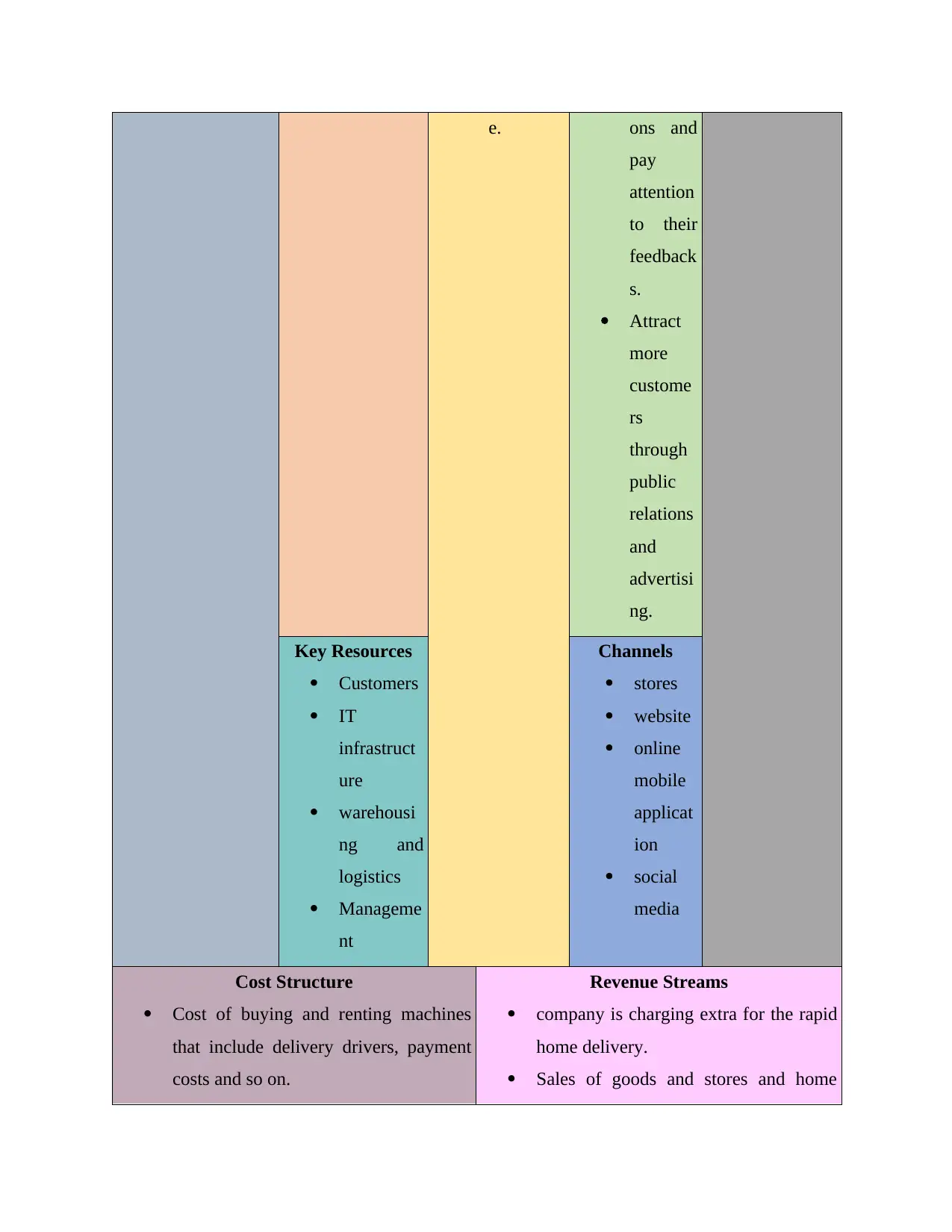
e. ons and
pay
attention
to their
feedback
s.
Attract
more
custome
rs
through
public
relations
and
advertisi
ng.
Key Resources
Customers
IT
infrastruct
ure
warehousi
ng and
logistics
Manageme
nt
Channels
stores
website
online
mobile
applicat
ion
social
media
Cost Structure
Cost of buying and renting machines
that include delivery drivers, payment
costs and so on.
Revenue Streams
company is charging extra for the rapid
home delivery.
Sales of goods and stores and home
pay
attention
to their
feedback
s.
Attract
more
custome
rs
through
public
relations
and
advertisi
ng.
Key Resources
Customers
IT
infrastruct
ure
warehousi
ng and
logistics
Manageme
nt
Channels
stores
website
online
mobile
applicat
ion
social
media
Cost Structure
Cost of buying and renting machines
that include delivery drivers, payment
costs and so on.
Revenue Streams
company is charging extra for the rapid
home delivery.
Sales of goods and stores and home
Paraphrase This Document
Need a fresh take? Get an instant paraphrase of this document with our AI Paraphraser
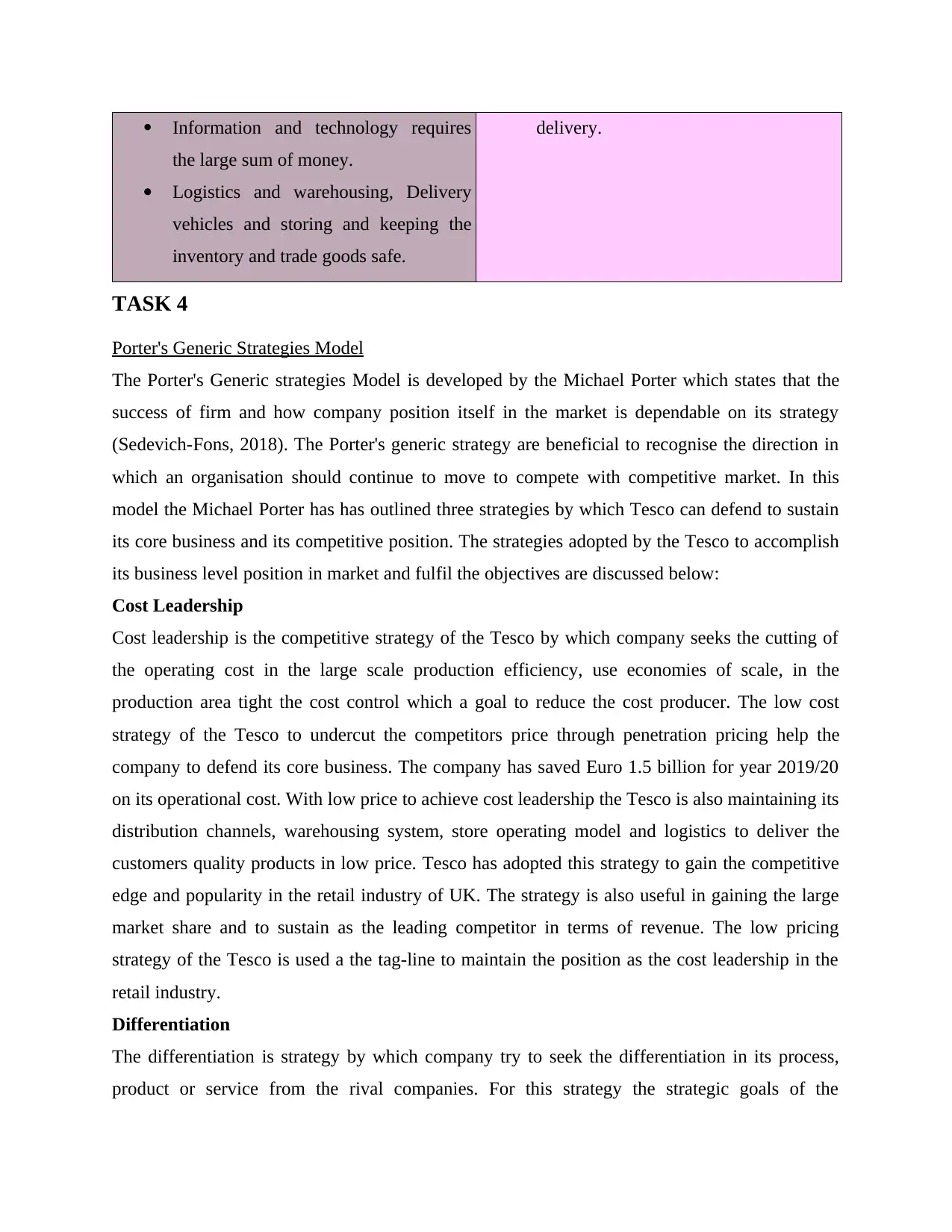
Information and technology requires
the large sum of money.
Logistics and warehousing, Delivery
vehicles and storing and keeping the
inventory and trade goods safe.
delivery.
TASK 4
Porter's Generic Strategies Model
The Porter's Generic strategies Model is developed by the Michael Porter which states that the
success of firm and how company position itself in the market is dependable on its strategy
(Sedevich-Fons, 2018). The Porter's generic strategy are beneficial to recognise the direction in
which an organisation should continue to move to compete with competitive market. In this
model the Michael Porter has has outlined three strategies by which Tesco can defend to sustain
its core business and its competitive position. The strategies adopted by the Tesco to accomplish
its business level position in market and fulfil the objectives are discussed below:
Cost Leadership
Cost leadership is the competitive strategy of the Tesco by which company seeks the cutting of
the operating cost in the large scale production efficiency, use economies of scale, in the
production area tight the cost control which a goal to reduce the cost producer. The low cost
strategy of the Tesco to undercut the competitors price through penetration pricing help the
company to defend its core business. The company has saved Euro 1.5 billion for year 2019/20
on its operational cost. With low price to achieve cost leadership the Tesco is also maintaining its
distribution channels, warehousing system, store operating model and logistics to deliver the
customers quality products in low price. Tesco has adopted this strategy to gain the competitive
edge and popularity in the retail industry of UK. The strategy is also useful in gaining the large
market share and to sustain as the leading competitor in terms of revenue. The low pricing
strategy of the Tesco is used a the tag-line to maintain the position as the cost leadership in the
retail industry.
Differentiation
The differentiation is strategy by which company try to seek the differentiation in its process,
product or service from the rival companies. For this strategy the strategic goals of the
the large sum of money.
Logistics and warehousing, Delivery
vehicles and storing and keeping the
inventory and trade goods safe.
delivery.
TASK 4
Porter's Generic Strategies Model
The Porter's Generic strategies Model is developed by the Michael Porter which states that the
success of firm and how company position itself in the market is dependable on its strategy
(Sedevich-Fons, 2018). The Porter's generic strategy are beneficial to recognise the direction in
which an organisation should continue to move to compete with competitive market. In this
model the Michael Porter has has outlined three strategies by which Tesco can defend to sustain
its core business and its competitive position. The strategies adopted by the Tesco to accomplish
its business level position in market and fulfil the objectives are discussed below:
Cost Leadership
Cost leadership is the competitive strategy of the Tesco by which company seeks the cutting of
the operating cost in the large scale production efficiency, use economies of scale, in the
production area tight the cost control which a goal to reduce the cost producer. The low cost
strategy of the Tesco to undercut the competitors price through penetration pricing help the
company to defend its core business. The company has saved Euro 1.5 billion for year 2019/20
on its operational cost. With low price to achieve cost leadership the Tesco is also maintaining its
distribution channels, warehousing system, store operating model and logistics to deliver the
customers quality products in low price. Tesco has adopted this strategy to gain the competitive
edge and popularity in the retail industry of UK. The strategy is also useful in gaining the large
market share and to sustain as the leading competitor in terms of revenue. The low pricing
strategy of the Tesco is used a the tag-line to maintain the position as the cost leadership in the
retail industry.
Differentiation
The differentiation is strategy by which company try to seek the differentiation in its process,
product or service from the rival companies. For this strategy the strategic goals of the
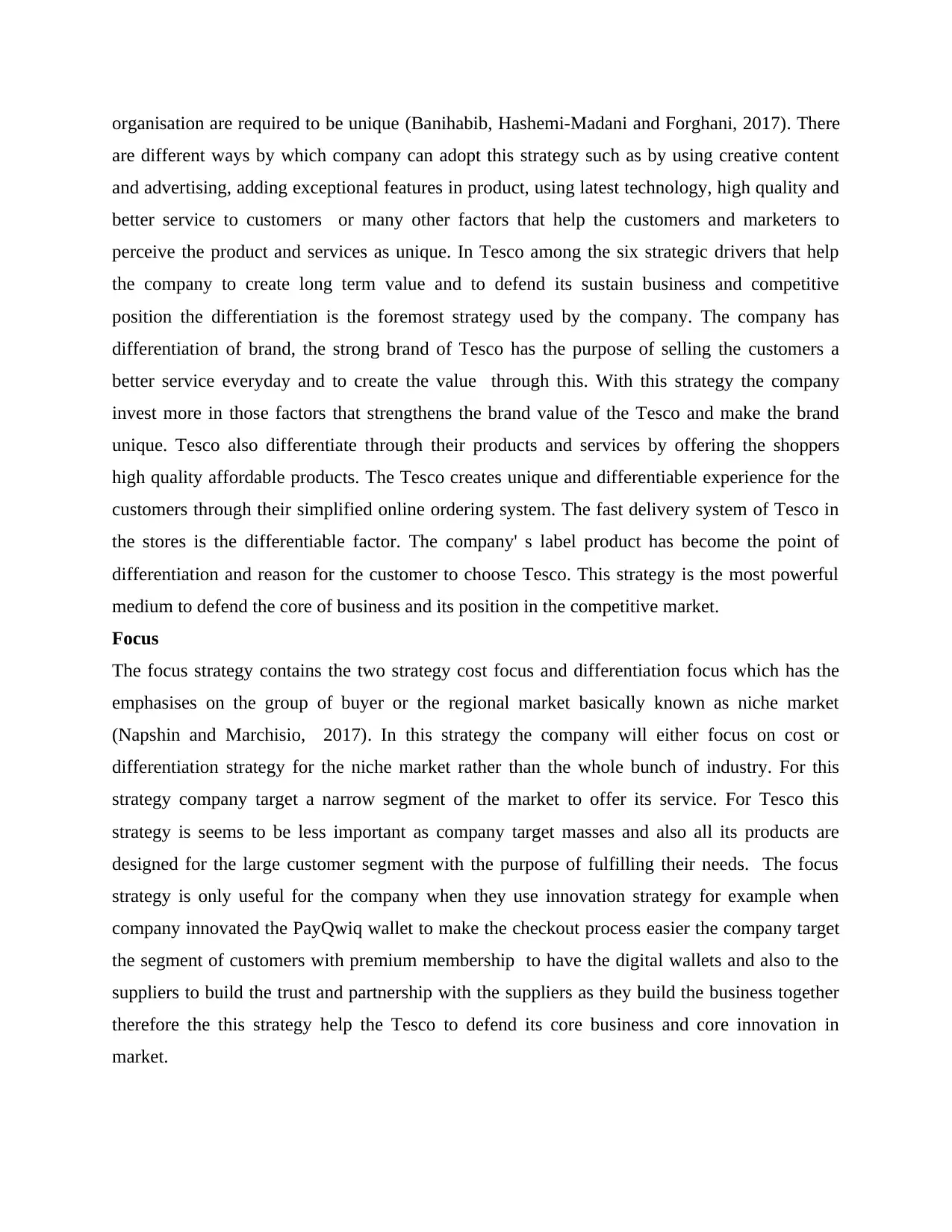
organisation are required to be unique (Banihabib, Hashemi-Madani and Forghani, 2017). There
are different ways by which company can adopt this strategy such as by using creative content
and advertising, adding exceptional features in product, using latest technology, high quality and
better service to customers or many other factors that help the customers and marketers to
perceive the product and services as unique. In Tesco among the six strategic drivers that help
the company to create long term value and to defend its sustain business and competitive
position the differentiation is the foremost strategy used by the company. The company has
differentiation of brand, the strong brand of Tesco has the purpose of selling the customers a
better service everyday and to create the value through this. With this strategy the company
invest more in those factors that strengthens the brand value of the Tesco and make the brand
unique. Tesco also differentiate through their products and services by offering the shoppers
high quality affordable products. The Tesco creates unique and differentiable experience for the
customers through their simplified online ordering system. The fast delivery system of Tesco in
the stores is the differentiable factor. The company' s label product has become the point of
differentiation and reason for the customer to choose Tesco. This strategy is the most powerful
medium to defend the core of business and its position in the competitive market.
Focus
The focus strategy contains the two strategy cost focus and differentiation focus which has the
emphasises on the group of buyer or the regional market basically known as niche market
(Napshin and Marchisio, 2017). In this strategy the company will either focus on cost or
differentiation strategy for the niche market rather than the whole bunch of industry. For this
strategy company target a narrow segment of the market to offer its service. For Tesco this
strategy is seems to be less important as company target masses and also all its products are
designed for the large customer segment with the purpose of fulfilling their needs. The focus
strategy is only useful for the company when they use innovation strategy for example when
company innovated the PayQwiq wallet to make the checkout process easier the company target
the segment of customers with premium membership to have the digital wallets and also to the
suppliers to build the trust and partnership with the suppliers as they build the business together
therefore the this strategy help the Tesco to defend its core business and core innovation in
market.
are different ways by which company can adopt this strategy such as by using creative content
and advertising, adding exceptional features in product, using latest technology, high quality and
better service to customers or many other factors that help the customers and marketers to
perceive the product and services as unique. In Tesco among the six strategic drivers that help
the company to create long term value and to defend its sustain business and competitive
position the differentiation is the foremost strategy used by the company. The company has
differentiation of brand, the strong brand of Tesco has the purpose of selling the customers a
better service everyday and to create the value through this. With this strategy the company
invest more in those factors that strengthens the brand value of the Tesco and make the brand
unique. Tesco also differentiate through their products and services by offering the shoppers
high quality affordable products. The Tesco creates unique and differentiable experience for the
customers through their simplified online ordering system. The fast delivery system of Tesco in
the stores is the differentiable factor. The company' s label product has become the point of
differentiation and reason for the customer to choose Tesco. This strategy is the most powerful
medium to defend the core of business and its position in the competitive market.
Focus
The focus strategy contains the two strategy cost focus and differentiation focus which has the
emphasises on the group of buyer or the regional market basically known as niche market
(Napshin and Marchisio, 2017). In this strategy the company will either focus on cost or
differentiation strategy for the niche market rather than the whole bunch of industry. For this
strategy company target a narrow segment of the market to offer its service. For Tesco this
strategy is seems to be less important as company target masses and also all its products are
designed for the large customer segment with the purpose of fulfilling their needs. The focus
strategy is only useful for the company when they use innovation strategy for example when
company innovated the PayQwiq wallet to make the checkout process easier the company target
the segment of customers with premium membership to have the digital wallets and also to the
suppliers to build the trust and partnership with the suppliers as they build the business together
therefore the this strategy help the Tesco to defend its core business and core innovation in
market.
⊘ This is a preview!⊘
Do you want full access?
Subscribe today to unlock all pages.

Trusted by 1+ million students worldwide
1 out of 17
Related Documents
Your All-in-One AI-Powered Toolkit for Academic Success.
+13062052269
info@desklib.com
Available 24*7 on WhatsApp / Email
![[object Object]](/_next/static/media/star-bottom.7253800d.svg)
Unlock your academic potential
Copyright © 2020–2025 A2Z Services. All Rights Reserved. Developed and managed by ZUCOL.





